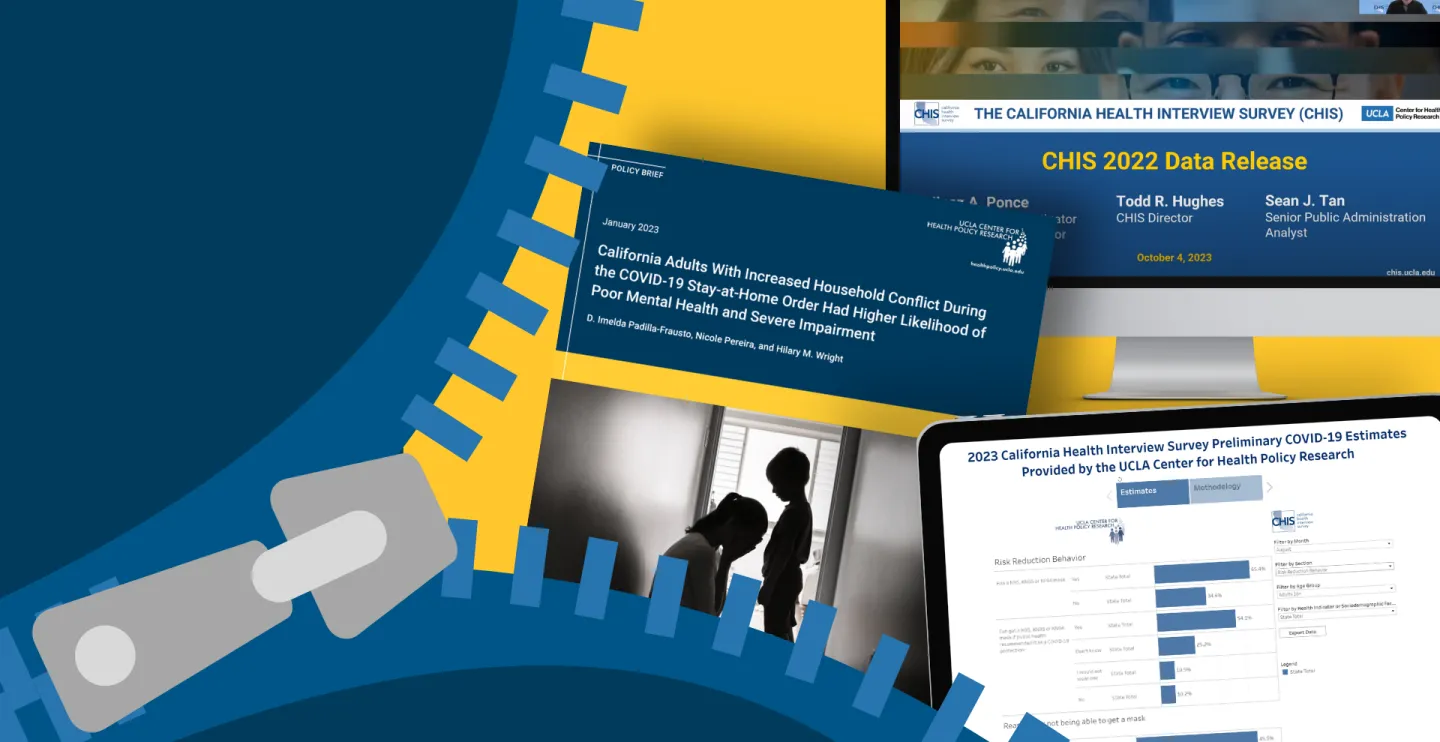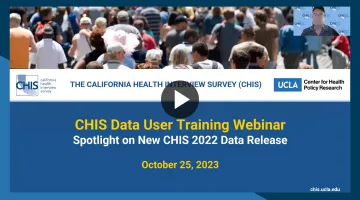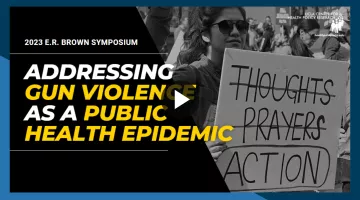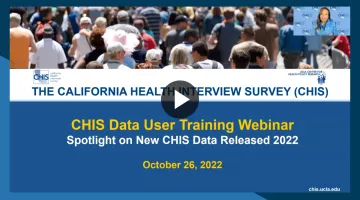CHIS Making an Impact 2023
- Home
- Our Work
- California Health Interview Survey
- CHIS Making an Impact 2023
- A Look Back at 2023
CHIS Annual Data Release
High rates of food insecurity, hate incidents, and difficulties accessing health care were at the forefront of issues that plagued Californians in 2022, according to the annual California Health Interview Survey (CHIS) data released on October 4, 2023.
Food insecurity on the rise
The data revealed that a growing number of low-income Californian adults (earning less than 200% of the federal poverty level) struggled to access nutritious and affordable food: 44% were not able to afford enough food in 2022, up from 35.8% in 2020.
The most significant increase between 2020 and 2022 occurred among working-age adults, jumping 11 percentage points among 18–24 year olds to 47.7%; 8.6 percentage points among 25–39 year olds to 51.4%; and 12.4 percentage points among 40–64 year olds to 48%. Latinx adults experienced the highest increase in food insecurity with a 9.6 percentage point increase to 47%. However, adults who identify with two or more races and Black or African American adults had among the highest overall rates of food insecurity in 2022: 49.9% and 48.6%, respectively.
Brand new questions on hate incidents
The 2022 survey added new and expanded questions on Californians’ experiences with hate crimes or incidents. While more than 1 in 9 (11.7%) adults said they have ever been a victim of a hate crime or incident, the rate among Black or African American adults was 1 in 4 (26.2%) — four times as high as the 6.3% for white adults. The figure was 17.4% for adults who identify with two or more races, 15.6% for Asian adults, and 13.5% for Latinx adults.
Health insurance coverage hit an all-time high, but access to care impacts many
A bright spot in the data was that the proportion of Californians who had health insurance in 2022 reached 94.8% — the highest rate recorded by CHIS. Latinx adults have the lowest health coverage rates, but saw the most significant increase in coverage: from 86% to 89.4%.
However, difficulty accessing care was a concern among many, with more than 1 in 5 (22.4%) adults indicating they were never able to get a doctor’s appointment within two days when they tried, up from 12.3% in 2020. Similarly, one-third (33.3%) of adults who needed mental health care said difficulty getting an appointment was the reason they didn’t get the help they needed in 2022, up from 24.4% in 2021.
Pattern of higher mental health needs
About 1 in 6 (16.4%) adults reported in 2022 that they likely had serious psychological distress (SPD) in the past year, similar to 2021 (17%) and higher than in 2019 (13%) and 2020 (12.2%).
LGBT adults had significantly higher rates of SPD: 61.6% of transgender or gender nonconforming adults; 46.9% of bisexual adults; and 29.7% of gay, lesbian, or homosexual adults experienced SPD compared to 13.6% of straight or heterosexual adults and 15.8% of cisgender adults. Nearly 1 in 5 adults in 2022 (18.9%) and 2021 (19.1%) said they experienced suicide ideation within the past 12 months, up from 12.2% in 2020.
COVID-19 vaccination status and views
Among teens who were partially vaccinated or not vaccinated, 21% said the reason for not being fully vaccinated is because their parents didn’t want them to get the vaccine and 27.6% said it’s because they think the vaccine is unnecessary.
Nearly 1 in 3 (30.7%) adults who have had COVID-19 experienced symptoms for two months or longer (long COVID). Latinx adults (38.4%) had higher rates of long COVID compared to white adults (24.1%).
“While the state of California is often seen as a leader in striving toward health equity, the 2022 data highlights some of the ongoing disparities that are impacting Californians’ overall well-being,” said Todd Hughes, CHIS director. “This isn’t just a collection of numbers. This is a story of Californians: their challenges, their fears, and their needs. This is the key to shaping a brighter, healthier future for all.”
Our 2022 data reveal a complex health landscape — deepening food insecurity, hate incidents, challenges in accessing health care, and an ongoing mental health crisis — that paints a stark picture of the challenges faced by California’s large and diverse population.
Watch the CHIS Data Release
2022 CHIS By the Numbers
22,423
households interviewed
18,973
adult interviews completed by web
2,490
interviews completed by phone
CHIS Preliminary COVID-19 Estimates Dashboard
When the COVID-19 pandemic began in 2020, little was known about the virus and the broad impact — health, economic, and personal — it would have on people around the world.
Focused on providing timely insights, the California Health Interview Survey (CHIS) quickly adapted survey operations, adding a series of COVID-19 questions to CHIS immediately and abbreviating data processing procedures to produce monthly estimates.
From questions on COVID illness, to risk- reduction behaviors and mask use, to financial impacts such as job loss and essential worker status, CHIS provided public health departments, policymakers, legislators, and other decision makers data through the development of publicly accessible CHIS Preliminary COVID-19 Estimates dashboards.
CHIS continued to provide these monthly estimates for 2020, 2021, 2022, and 2023, and added timely questions, including experiences with long COVID; vaccination status and views on the vaccine; reasons for not getting the vaccine; and personal impacts, including various financial difficulties and unfair treatment due to race or ethnicity. The data can also be viewed by sociodemographic factors, including age, race and ethnicity, citizenship status, income level, risk factor, California region, and more to better understand the unique challenges of California’s diverse population.
In 2023, CHIS released its final set of monthly estimates, which included responses from 20,134 Californians (16,786 adults and 3,348 children and teens), from March through August 2023.
Findings from the August 2023 dashboard include:
COVID-19 vaccine status and testing
- 1 in 3 (32%) adults said they would not get additional COVID-19 vaccine doses, even if recommended by health guidelines.
- 23% of adults who completed the primary vaccine series for COVID-19 have not received any additional doses or boosters.
- 47% of adults who received a positive test result for COVID-19 got their results from a self-test kit; 30% from a clinic, hospital, lab, or other testing facility; and 24% from both a testing site and a self-test kit.
Californians’ reasons for not completing the primary vaccine series for COVID-19
- 46% of adults and 30% of teens and children thought a vaccine for COVID-19 is unnecessary.
- 46% of adults and 45% of teens and children were worried about the side effects.
- 37% of children and teens said their parents did not want them to get the vaccine.
- 32% of adults didn’t believe in vaccines in general.
Experiences with Long COVID
- 30% of adults experienced COVID symptoms for two months or longer.
- By income level: 46% of adults with incomes 0–99% of the federal poverty level (FPL) and 42% of adults with incomes 100–199% FPL experienced COVID-19 symptoms for two months or longer, significantly higher than adults with incomes 300% FPL and above (23%).
- By race and ethnicity: 44% of Latinx adults experienced COVID-19 symptoms for two months or longer, two times higher than 22% of white adults.
Personal impacts of the pandemic
- 14% of adults had financial difficulties paying their rent or mortgage.
- By race and ethnicity: 20% of Latinx adults had difficulty with paying their rent or mortgage, more than two times higher than 8% of white adults.
- By income level: 28% of adults with incomes 0–99% FPL and 24% of adults with incomes 100–199% FPL compared to 7% of adults with incomes 300% FPL and above.
- By household size: 25% of adults with five or more people in their household compared to 10% of adults with one or two people in their household.
- By insurance status: 31% of adults without health insurance compared to 12% of adults with health insurance.
- 3% of adults were treated unfairly because of their race or ethnicity.
- 3% of adults had to quit their job to take care of themselves or a family member due to COVID-19 illness.
- 2% of adults had difficulty obtaining child care or had an increase in child care expenses.
Although you may think some of the percentages are small at 2% — when considering the overall California population, we're talking about more than half a million Californians. There is nothing insignificant about that.
29,722
total visits to the CHIS COVID-19 dashboards and website
CHIS 2021-2022 Methodology Reports
In September 2023, CHIS released a series of five methodology reports that provide the most in-depth descriptions of CHIS sampling, data collection, data processing, response rates, and weighting and variance estimation methods.
Report 1: Sample Design: describes the design features
of CHIS and alternatives that were considered, and provides analysts information about the sampling methods used for both the household and person (within household) sampling.
Report 2: Data Collection Methods: describes the protocols followed to contact sampled addresses and
how data were collected: screening interviews, recruiting and training of data collectors, data collection results, and quality control procedures.
Report 3: Data Processing Procedures: describes the
data processing and editing procedures and steps taken
to ensure data quality, discusses geographic coding, and how the race and ethnicity survey items were coded for CHIS.
Report 4: Response Rates: describes the contact methods, response rates, and procedures used to increase response rates.
Report 5: Weighting and Variance Estimation: describes the weighting approach and adjustments, calibration and imputation procedures, and variance estimation methods, and presents the steps used to create the analytical weights for analyzing the data from the adult, child, and adolescent interviews.
Read more on CHIS Methodology...
CHIS Data Tools
AskCHIS™
A free and easy-to-use online health query system that allows users to quickly search for health statistics by county, region, and state. AskCHIS™ provides reliable data on a wide range of topics across many sociodemographic factors.
The 2022 data, which was made available in AskCHIS™ in October 2023, includes 391 total variables/topics, with about 10 million different CHIS estimates available to explore. AskCHIS™ includes data beginning in 2001, so users can look at patterns and trends across two decades.
Data can be viewed in tables, charts, and graphs; emailed; and also exported as Excel files.
CHIS’ most popular tool, AskCHIS™ has received nearly 1.8 million queries since inception.
AskCHIS™ By the Numbers
97,882
queries run in AskCHIS™ in 2023
1,791,341
queries run in AskCHIS™ since inception
2,988
total AskCHIS™ users
AskCHIS™ NE
An online data dissemination and visualization platform featuring data on select health topics at the local level.
Using a sophisticated modeling technique called Small Area Estimation (SAE), AskCHIS™ NE provides data on the most granular levels of geography: ZIP code, city, county, legislative district, and census tract, helping to target health interventions based on a neighborhood’s specific needs.
Currently, AskCHIS™ NE topics include asthma, diabetes, heart disease, food insecurity, mental health, health and insurance status, tobacco use, and sugary drink consumption.
Users can produce tables, thematic maps, and bar charts for easy visualization.
AskCHIS™ NE By the Numbers
9,189
queries run in AskCHIS™ in 2023
57,284
queries run in AskCHIS™ NE since inception
3,549
total AskCHIS™ NE users
Users can dig deep into California's health issues with comprehensive statewide CHIS
data files on a variety of topics.
PUFs, which are free and accessible to anyone via a brief application, enable researchers to customize and run their own statistical code. Files are available in various statistical programming formats — SAS, SPSS, and STATA.
Designed for advanced data users, PUFs include microdata files, hundreds of variables and detailed demographic information, and a data dictionary and survey questionnaire.
Learn more about Public Use Files (PUFs)...
Researchers can apply to analyze confidential CHIS data, data-sensitive variables, and/or geocoded data through the CHIS Data Access Center (DAC). The DAC provides researchers with remote access to confidential data files in a secure, controlled environment that protects the confidentiality of respondents.
The confidential CHIS files maintained in the DAC contain detailed geographic identifiers, complete demographic information for survey respondents, and highly sensitive information (e.g., sexual behaviors, mental health treatment) that has been specifically excluded from the freely available CHIS PUFs.
Access to confidential CHIS data requires a research application, review, and approval.
Learn more about the DAC...
Health Profiles provide quick and easy access to commonly requested health indicators from CHIS in easy-to-read PDF documents. The profiles deliver health estimates on top topics, such as insurance status, disease prevalence, health behaviors, and overall health status for multiple age groups (adults, children, teens); racial and ethnic groups; and geographic regions (counties, regions, Los Angeles Service Planning Areas, and San Diego Health and Human Services Agency region).
Learn more about Health Profiles...























